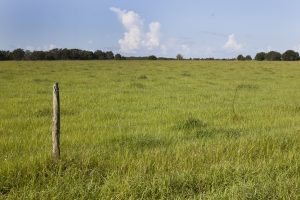Spring and summer is the time of year many ranchers look into reestablishing their pastures or establishing new ones. The temperatures are warm and hopefully we have moisture coming our way. Before making the jump into renovating a pasture there are options to consider. Some options to consider are what are what is the current situation, what are the forage needs and what type of forage best meets the needs and location of the pasture.
For those producers considering reestablishing a current pasture the question may be asked, at what point do we start over? The recommendation for reestablishing a pasture is when there is 40% or less of the desirable forage species available in the pasture. There are situations where over-seeding may be possible along with management to transition an undesirable pasture situation if the pasture is currently between 40 and 75% of your desired species still available.
Establishing a new pasture may be desirable for many reasons, such as changing the lands use, increasing forage production, changing forage species, insect damage, or weed invasion, just to name a few. The best reason to establish a new pasture is because it is right for your operation. When establishing a new pasture do it right the first time. The cost of establishment is estimated at $500 per acre. Doing it right the first time will save both time and money.
The first step to establish a new pasture is to do research and find the right forage for you and your operation as there are many forage varieties available. Take some time to evaluate the area to established and see how the soil drains, does the site stay wet, is it very dry or a combination of the two. Also consider what the pasture will be used for. Will it be for hay production, grazing, or both? What is the stocking rate of the pasture, or will it be intensively managed? All these factors need to be considered to establish a pasture to meet operation’s needs.
Once the site has been analyzed and a decision is made as to what will be planted you are ready to get started. Prior to planting the new forage your soil should be tested. This simple test will indicate what needs to be add to the soil for the best forage growth. Planning ahead is key as lime or dolomite can take up to six months to fully react with the soil to reduce the soil pH, if needed. Once the soil has been amended as needed you are ready to prepare your seedbed. Remove any unwanted brush, trees, and stumps from the area. Once this is complete plow or disc the ground multiple times to kill any unwanted forage and weeds. A well-prepared seedbed will be free of vegetation, sticks, clumps, foreign material, it will be smooth and reasonably level, firm and the target pH has been achieved. To ensure the pH is correct another soil sample may be needed.
If a bahiagrass pasture is being established it is recommended that seed is purchased from a reputable company that is selling local, fresh seed with a germination rate of 80% or better. Recommended seeding rates range 20-30 pounds of viable seed per acre. Once the seed is spread cover with about ¼” of soil or roll the seedbed to pack the seed. Rolling will also assist in moisture retention. Moisture is needed for germination and also establishment of the seed. After emergence of the seedlings, it is recommended to apply 30 pounds of nitrogen per acre, phosphate as recommended from your soil sample and 50% of the recommended potash per acre. Forty to 50 days later it is recommended to apply another 50 pounds of nitrogen per acre and the other 50% of recommended potash per acre.
When establishing a pasture from vegetative propagated forages well fertilized planting material that is from mature plants should be used. It is recommended to spread the material as soon as possible after it is harvested. An average of 1,500 to 1,800 pounds of material per acre should be used. Rates vary depending on the forage variety being used. One acre of material should plant approximately 13-15 acres. Moisture is a must when planting vegetative materials. Once the material is spread it should be crimped into the soil and rolled to preserve the soil moisture. Consistent moisture is needed after planting as well. When planting bermudagrass or stargrass it is recommended to fertilize when plants begin to grow with 30 pounds of nitrogen per acre and the potash and all of the phosphate recommended from the soil test results per acre. When stolons (runners) begin to grow it is recommended to apply another 70 pounds of nitrogen per acre 50% of potash per the soil sample results. When establishing limpograss it is recommended to apply 30 pounds of nitrogen per acre, all of the phosphorus and 50% of the potash recommended from your soil test results per acre after the grass begins to grow. Thirty to 50 days later it is recommended to apply another 70 pounds of nitrogen and the remaining 50% of potash per your soil test results per acre.
When establishing pastures it is important to plan ahead and do it right the first time. Use proper soil fertility to allow a good establishment of the forages before grazing. Following control measures to reduce weeds in your new pasture will allow for many years of use.
Sources:
Wallau, M. O., Vendramini, J. M. B., and Yarborough, J. K. 2024. Bermudagrass Production in Florida (SS-AGR-60) https://edis.ifas.ufl.edu/publication/AA200
Vendramini, J. M. B., Sollenberger, L. E., Quesenberry, K. H., Wallau, M. O., and Dubeaux, Jr, J. 2021. Limpgrass (Hemarthria Altissima): Overview and Management (SS-AGR-320) https://edis.ifas.ufl.edu/publication/AG330
 0
0

